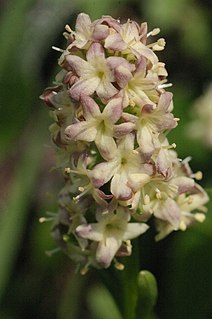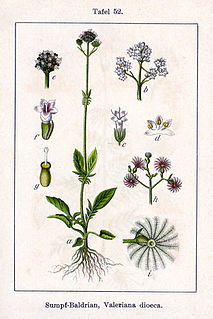
Valerian is a perennial flowering plant native to Europe and Asia. In the summer when the mature plant may have a height of 1.5 metres (5 ft), it bears sweetly scented pink or white flowers that attract many fly species, especially hoverflies of the genus Eristalis. It is consumed as food by the larvae of some Lepidoptera species, including the grey pug.

Valeriana is a genus of flowering plants in the family Caprifoliaceae, members of which may by commonly known as valerians. It contains many species, including the garden valerian, Valeriana officinalis. Some species are native to Europe, others to North America and South America.

Draba aretioides is a species of flowering plant in the family Brassicaceae. It is found only in Ecuador. Its natural habitat is rocky areas.

Lysipomia aretioides is a species of plant in the family Campanulaceae. It is endemic to Ecuador. Its natural habitats are subtropical or tropical high-altitude shrubland and subtropical or tropical high-altitude grassland. It is threatened by habitat loss.
Oldenlandia aretioides is a species of plant in the family Rubiaceae. It is endemic to Yemen.
Valeriana alypifolia is a species of plant in the family Caprifoliaceae. It is endemic to Ecuador. Its natural habitat is subtropical or tropical high-altitude grassland.
Valeriana asterothrix is a species of plant in the family Caprifoliaceae. It is endemic to Ecuador. Its natural habitats are subtropical or tropical moist montane forests and subtropical or tropical high-altitude shrubland.
Valeriana buxifolia is a species of plant in the family Caprifoliaceae. It is endemic to Ecuador. Its natural habitats are subtropical or tropical high-altitude shrubland and subtropical or tropical high-altitude grassland.
Valeriana cernua is a species of plant in the family Caprifoliaceae. It is endemic to Ecuador. Its natural habitat is subtropical or tropical high-altitude grassland.
Valeriana coleophylla is a species of plant in the family Caprifoliaceae. It is endemic to Ecuador. Its natural habitats are subtropical or tropical moist montane forests and subtropical or tropical high-altitude shrubland.
Valeriana secunda is a species of plant in the family Caprifoliaceae. It is endemic to Ecuador. Its natural habitat is subtropical or tropical high-altitude grassland.
Bryomorphe is a monotypic genus of flowering plants in the daisy family, Asteraceae, containing the single species Bryomorphe aretioides. It is endemic to South Africa, where it grows in sandstone fynbos in the Western Cape.

Valeriana sitchensis is a species of valerian known by the common name Sitka valerian. It is native to northwestern North America from Alaska and northern Canada to Montana to northern California, where it grows in many types of habitat, including moist mountain forests. In moist subalpine meadows, it is often one of the most common plants. This is a rhizomatous perennial herb producing a stout, erect stem to about 70 centimeters in maximum height, but known to exceed one meter at times. The leaves vary in size and shape, often having deep lobes or being composed of several leaflets. The inflorescence is a cyme of many white or pink-tinged flowers, each under a centimeter wide. The flower has five corolla lobes and three whiskery stamens protruding from the center.

Valeriana celtica is a species of plant in the family Caprifoliaceae. It is also known as Alpine valerian and valerian spikenard. It is endemic to the Eastern Alps and to the Graian and Pennine Alps. It grows as a perennial herb 5 to 15 cm (2.0–5.9 in) tall. Until the 1930s, it was extensively harvested for export to Asia for use in perfumes. The root has been used as a folk remedy as a nerve tonic.

Eupithecia valerianata, the valerian pug, is a moth of the family Geometridae. The species was first described by Jacob Hübner in 1813. It is found from Great Britain, through central Europe to western Russia, Belarus and northern Iran.
Townsendia rothrockii is a species of flowering plant in the aster family known by the common name Rothrock's Townsend daisy. It is endemic to Colorado in the United States, where there are 35 occurrences across thirteen counties. Reports of the plant from New Mexico are false.
Codatractus valeriana, the valeriana skipper, is a species of dicot skipper in the butterfly family Hesperiidae. It is found in Central America and North America.
Azorella aretioides is a species of flowering plant in the genus Azorella found in Colombia and Ecuador. Azorella aretioides var. elongata is a variety of the species, also found in Colombia and Ecuador.

Valeriana dioica, the marsh valerian, is a species of flowering plant in the genus Valeriana, native to Europe and Anatolia. It is typically found in calcareous fens.








